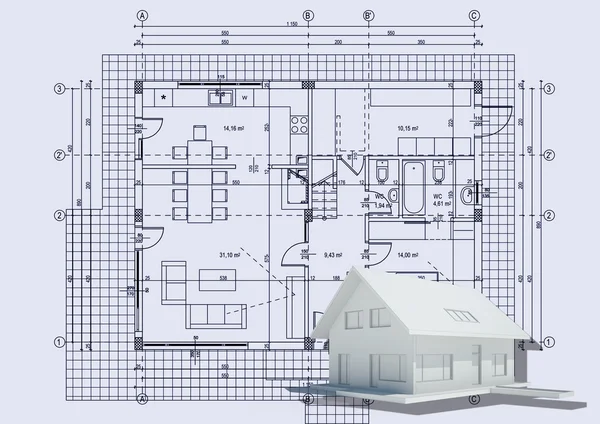
Are you considering building a 1,500 sq ft house and wondering about the land requirements? Understanding the essential land specifications for constructing a 1,500 sq ft house is crucial for various stakeholders involved in real estate and construction projects.
For homebuyers, acquiring land for a new home is a significant decision that requires a clear understanding of the space needed to accommodate a 1,500 sq ft residence. Homebuilders and construction professionals rely on precise land requirements to plan and execute residential projects effectively.
Real estate investors seeking opportunities in residential development or resale must grasp the land dimensions necessary for a 1,500 sq ft house to make informed investment choices. Land developers and urban planners leverage insights into land needs for housing projects to drive sustainable and efficient development practices.
Home designers and architects play a key role in shaping residential properties and rely on accurate land measurements to create functional and aesthetically pleasing dwellings. Landowners evaluating the potential of their property for residential use benefit from understanding the land requirements for a 1,500 sq ft house.
Moreover, real estate agents, government officials, and the general public can gain valuable knowledge about the land-to-building ratios and dimensions crucial for building a 1,500 sq ft residence. Stay tuned as we delve into the specifics of determining land requirements for a 1,500 sq ft house to empower your decision-making process in the realm of real estate and construction.
Calculating Land Area for a 1,500 Sq Ft House
Determining the land area needed to construct a 1,500 sq ft house involves considering various factors that influence the overall land requirement. Factors such as setbacks, zoning regulations, and the house’s footprint play crucial roles in determining the land size necessary for a 1,500 sq ft house. Setbacks refer to the required distance between the structure and the property line.
Zoning regulations dictate the permissible land usage and building parameters within a specific area. Understanding these factors is essential for accurately calculating the land area required for a 1,500 sq ft house.
Factors Influencing Land Requirement
- Setbacks: Setbacks are a key consideration when determining the land area needed for a 1,500 sq ft house. Setbacks ensure adequate spacing between the house and property boundaries, contributing to safety and compliance with local building codes.
- Zoning Regulations: Zoning laws establish land usage guidelines, including setback requirements, building height restrictions, and permitted land use types. Complying with these regulations is crucial in determining the suitable land size for a 1,500 sq ft house.
- House’s Footprint: The design and layout of the house also impact the land requirement. A compact design may allow for a smaller land area, while a sprawling layout might necessitate more space. Considering the house’s footprint is vital in estimating the land needed for construction.
Case Studies and Examples
Real-world examples and case studies can provide valuable insights into the variations in land sizes required for 1,500 sq ft houses. By examining different design choices, locations, and land features, we can explore how these factors influence the overall land area needed. For instance, a house built on a compact urban lot may require creative design solutions to maximize space utilization, compared to a suburban property with more available land.
To further delve into the nuances of land requirements for a 1,500 sq ft house, exploring case studies that showcase diverse design approaches and location considerations can offer practical guidance for homebuyers, homebuilders, real estate investors, and other stakeholders involved in residential development projects.
For additional insights on factors influencing land requirement and average land requirements for 1,500 sq ft house construction, refer to reputable sources such as Atlas Homes LLC and My Seattle Home Search.
This section provides a foundational understanding of how to calculate the land area required for a 1,500 sq ft house, taking into account key considerations and real-world examples to inform decision-making in residential construction projects.
Land-to-Building Ratio Calculation
Understanding the land-to-building ratio is crucial in determining the space allocation between the building structure and the surrounding land. This ratio plays a vital role in residential construction projects, especially when planning for a 1,500 sq ft house.

Industry Standards and Recommendations
Industry standards and recommendations suggest a typical land-to-building ratio falls between 2.5:1 and 3.5:1 in most markets. This ratio signifies the square footage of the land parcel divided by the square footage of the building footprint. Understanding these benchmarks aids in efficient land use and optimal utilization of resources in construction projects.
Practical Application in Construction
The knowledge of the land-to-building ratio guides homebuilders and developers in optimizing land usage for 1,500 sq ft houses. By calculating this ratio, builders can determine the ideal land area required to accommodate a 1,500 sq ft house while maintaining an appropriate balance between the building footprint and open space. This calculation is fundamental in ensuring cost-effective and sustainable construction practices.
To calculate the land-to-building ratio, divide the total area of the land by the total area of the building structure. This calculation provides a clear understanding of how much land is needed to construct the desired 1,500 sq ft house efficiently.
For further insights, you can visit articles such as How To Calculate the Land-to-Building Ratio and Land to Building Ratio Calculator.
The concept of land-to-building ratio is valuable for various professionals and individuals, including homebuyers, homebuilders, real estate investors, land developers, urban planners, home designers/architects, landowners, real estate agents, government officials, and the general public, all seeking to understand the land requirements for residential properties.
Legal Considerations and Zoning Requirements
When it comes to determining the land requirements for a 1,500 sq ft house, legal considerations and zoning requirements play a crucial role in shaping the process. Understanding the impact of zoning laws on land usage and compliance with building codes is essential for a successful residential construction project.
Impact of Zoning Laws on Land Usage
Zoning laws are regulations that dictate how land can be utilized within specific areas. These laws play a significant role in determining where and how residential properties can be built. Zoning designations define the permissible land uses, building sizes, and structures allowed in different zones. They help maintain order in urban planning and ensure that communities are developed in a structured and organized manner. By adhering to zoning laws, developers can understand the limitations and opportunities for land development projects, including the minimum land size required for building a 1,500 sq ft house.
Understanding the different zoning classifications and regulations in your area is crucial before embarking on a residential construction project. Zoning laws vary by location and jurisdiction, so it’s essential to consult local authorities or zoning professionals to navigate the requirements effectively. By complying with zoning regulations, developers can ensure that their projects align with the intended land usage and contribute to sustainable and harmonious community development.
For further insights on the relationship between zoning laws and land development, you can explore more information here.
Compliance and Building Codes
Compliance with building codes and regulations is paramount when determining the land requirements for a 1,500 sq ft house. Building codes are a set of standards that specify the minimum requirements for building safety, structural integrity, and energy efficiency. By adhering to building codes, developers can ensure that the construction meets quality standards and guarantees the safety of occupants.
When planning a residential construction project, it is vital to consider the local building codes and regulations that govern land requirements. These codes encompass aspects such as setbacks, lot coverage, height restrictions, and environmental considerations. Failure to comply with building codes can result in costly delays, legal issues, or unsafe living conditions for residents.
To learn more about the basics of land use and zoning law in relation to building codes, you can refer to this insightful resource.
By understanding the significance of zoning laws and building codes in the context of land requirements for a 1,500 sq ft house, developers can navigate the legal landscape effectively and ensure successful project completion.
Finalizing the Land Purchase Decision

Once you have determined the land requirements for your 1,500 sq ft house, finalizing the land purchase decision becomes a crucial step in the process. Collaborating with professionals and evaluating future expansion possibilities are key factors to consider to ensure a successful residential construction project.
Collaboration with Professionals
Collaborating with real estate agents, architects, and urban planners can provide invaluable expertise when navigating the process of acquiring suitable land for building your dream home. Real estate agents can help you identify available properties that meet your requirements and budget. Architects can offer insights into the feasibility of constructing a house on a particular parcel of land, taking into account factors such as topography and building codes. Urban planners can assist in ensuring the land is designated for residential use and complies with zoning regulations.
Evaluating Future Expansion Possibilities
When purchasing land for a 1,500 sq ft house, it’s essential to consider the potential for future expansions or modifications. Evaluate whether the purchased land can accommodate additional space for future needs, such as a growing family or lifestyle changes. Assess the feasibility of expanding the existing structure or adding new amenities to enhance the functionality of your home. By planning for future growth, you can ensure that the land purchase decision aligns with your long-term vision for your residential property.
For more detailed information on buying land for residential construction projects, you can refer to reputable sources like How to Buy Land to Build a House and Purchasing Land for Residential Construction: Important Pointers.
Remember, the collaboration with professionals and thorough evaluation of future expansion possibilities are essential steps in finalizing your land purchase decision for a 1,500 sq ft house. By making informed choices, you can ensure a successful and satisfying outcome for your residential construction project.
Conclusion
In conclusion, determining the land requirements for a 1,500 sq ft house is crucial for successful residential development. Key points discussed include the need for a minimum of half an acre of land to accommodate a 1,500 sq ft home adequately. Thorough planning and adherence to regulations are essential to ensure the proper acquisition of land for residential projects.
For homebuyers, homebuilders, real estate investors, land developers, urban planners, home designers/architects, landowners, real estate agents, government officials, and the general public, understanding land requirements is vital in the process of building a new home or investing in residential development. By considering these factors and seeking professional guidance, individuals can navigate the complexities of land acquisition with confidence and efficiency.
Land size for house, Land requirements for 1,500 sq ft house, Zoning regulations for house size, Building dimensions for home, Lot size for residential construction, House size land considerations, Property development guidelines, Land acreage for house, Residential land size planning, Real estate development factors


I wanted to take a moment to express my sincere appreciation for the time I spent reading your post
Great !!!
Interesting Article
This is really informative